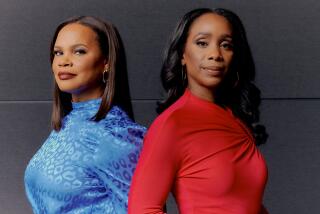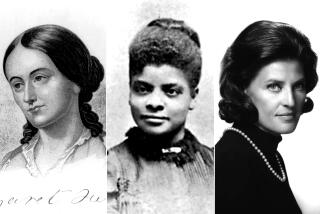A Woman’s Place : Current Events Get the Other Point of View on CNN and PBS
Every viewer has an opinion about whether TV news is fair and balanced. But this point is fact, not opinion: Women make up more than half the population of the United States, yet are woefully in the minority when it comes to commenting on major issues.
Two news analysis series, PBS’ new “To the Contrary” and CNN’s year-old “Crier & Co.,” are tipping the balance a little closer toward center. With rotating panels of high-profile women, both series offer a perspective that many argue is vital to the country’s political health.
And women are saying it’s about time!
“This is a terrific year for all-woman programs,” says Nancy DeStefanis, co-chair of the media activist group Women Are Good News. The group has criticized PBS’ public affairs programs for their lack of women guests and commentators--less than 15 percent on such shows as “McLaughlin Group” and “MacNeil/Lehrer NewsHour.”
“For the past 20 years in public television,” says DeStefanis, “women haven’t been seen nor heard, and this dims our credibility as leaders.”
Bonnie Erbe, “To the Contrary” host and co-creator, feels that the Anita Hill-Clarence Thomas hearings rekindled national interest in the way women view events. “I think our timing couldn’t be better,” says Erbe, a syndicated newspaper columnist and a legal affairs correspondent for Mutual/NBC Radio networks who has also appeared on “Crier & Co.”
Others add that the shows give a more complete picture of the news. Nina Totenberg, the National Public Radio correspondent who broke the story of Hill’s sexual harassment allegations against Thomas, says that journalism’s primarily male perspective can sometimes add up to only half a story.
“I was reading a New York Times article about Brock Adams (the state of Washington senator accused by unnamed sources of sexual abuse),” says Totenberg, a panelist on “To the Contrary.”
“The entire story was based on quotes from senators about what a tragedy this was for Adams. Nobody mentioned that if the allegations are true, we’re talking about serious felonial conduct.”
Women journalists can also help bring a human element to complicated or esoteric stories, says Washington Post columnist Dorothy Gilliam, a veteran of both shows. Looking forward to a future “To The Contrary” installment on gun control, Gilliam said she hopes to go beyond the usual arguments for and against the constitutionality of carrying weapons. “I would like to take it further and look at the social impact of guns,” she says. “We have 200 million guns (in the United States). What does this really say about the role of violence in this country?”
Women’s tendency to personalize social issues, says Gilliam, comes from their relative powerlessness in creating policy in the first place. “Issues only get talked about (by men) at the level of politics and government,” she says. “But women have an analysis that comes out of a lived experience, not just a projected one”--in other words, men make the rules; women live under the rules.
Such a philosophy explains why “Crier & Co.” and “To the Contrary” don’t focus only on so-called “women’s issues” such as sexual harassment. This season, “To the Contrary” will tackle stories such as the presidential race and June’s World Environmental Summit. “Crier” topics have included the referendum vote in South Africa and black conservatism in the United States.
The series use different formats. “To The Contrary,” with two topics an episode, is a “McLaughlin Group”-type of studio discussion--minus the “food-fight” atmosphere, plus political balance, stresses Erbe.
“Crier & Co.” looks more like ABC’s “Nightline,” with a single topic and guests who talk via remote feeds. On Mondays, the show also features panel discussions on a wider array of issues. Unlike “To The Contrary,” “Crier” sometimes uses male commentators.
“We tend to showcase women, but if the debate requires a male guest, then by all means,” says host Catherine Crier, a former Texas state district judge and co-anchor of CNN’s newscast “The World Today.”
Women’s movement pioneer Betty Friedan, director of USC’s Women, Men and the Media program, sees both shows as positive steps, both in terms of reporting events and deciding what’s newsworthy in the first place (what “news” is, of course, a subjective decision).
“There’s still an all-male definition of news,” she says. “But there’s a wonderful power here to transcend this polarization.”
Catherine Crier thinks that shows with women panelists have another benefit: A me-too effect on other news programs. “When we started this show, one individual said, ‘Won’t you run out of guests in a couple of weeks?’,” she said laughing. “What is so wonderful to me now is to look up and see the network shows picking up some guest that we had on our show. It’s very exciting to see it taking off.”
“To The Contrary” airs Fridays at 2:30 p.m. on KCET, Sundays at 11:30 p.m. on KPBS and Mondays at 10 p.m. KVCR.
“Crier & Co.” airs weekdays at 8:30 a.m. on CNN.
More to Read
The complete guide to home viewing
Get Screen Gab for everything about the TV shows and streaming movies everyone’s talking about.
You may occasionally receive promotional content from the Los Angeles Times.






